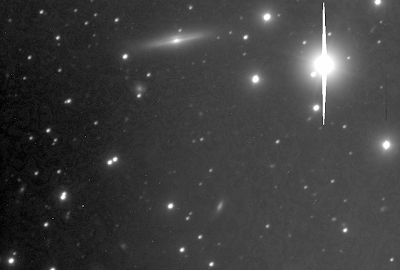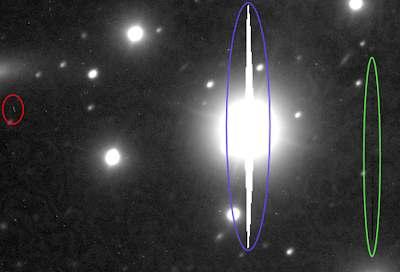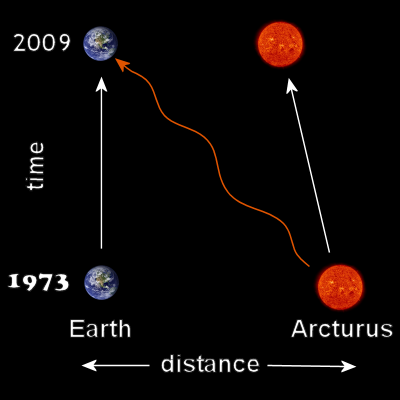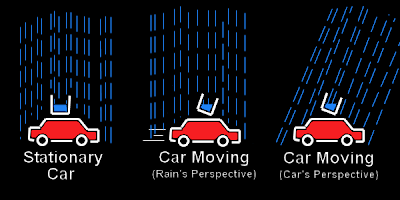David writes:
I recently read this article in Discover magazine and it got me thinking. The article is titled "Violent Birth of the Stars" by Adam Frank and it's in the February 2009 issue. It was all about star formation.
Anyway, here's the part that caught my eye: "A typical cluster will extend across a few light-years. Its parent cloud can stretch across 300 light years and contain enough matter to make a million stars. But a million stars do not form. Instead, star formation across a giant molecular cloud is a rather anemic process, and relatively few stellar nurseries arise. Only 10 percent of the mass of the cloud, on average, is converted through gravitational collapse into stars. The rest of it never collapses and eventually disperses into the tenuous interstellar medium throughout the galaxy."
What struck me about that is that in discussions of dark matter the usual argument is that there is not enough mass in a typical galaxy to explain its rotation. We're missing 90 percent of the mass. But the calculation of mass is based on luminous material. It would seem to me, based on the quote above, that no bizarre form of matter is necessary and it may simply be that the missing mass is gas and dust in the interstellar medium.
Am I reading this right, or is there more to the story than that?
Excellent question. To answer this, let's take a step back and talk about the background of galaxies and dark matter.
For those who don't know, galaxies are structures in our universe which can be thought of as giant "star cities", comprising billions of stars all gravitationally bound to one another. Our own galaxy, the Milky Way, contains around 300 billion stars. It's visible at night from dark locations, extending as a luminous band around the sky. That band is actually the combined starlight of billions of distant stars both like and unlike our own Sun.
Galaxies comes in a few different flavors, the most common being spirals, ellipticals, and irregulars:

Spirals tend to be disc-shaped with a distinct central bulge and noticeable spiral arms. Ellipticals tend to be very homogeneous and redder than spirals (indicating an older population of stars). Irregulars tend to be just that: irregularly-shaped.
In addition to all these billions of stars, spirals and irregular galaxies have an appreciable amount of hydrogen gas and dust. In the case of many irregulars, more mass will be found in their gas than in their stars. For a spiral galaxy like our Milky Way, gas may comprise a good 25% of the mass found in stars. Many ellipticals, on the other hand, appear to have no gas at all.
Now, this gas is actually the material from which stars are created. Its most ubiquitous form throughout a galaxy is as a hot diffuse medium (somewhere around 10,000K). Occasionally, however a large swath of hydrogen gas begins to cools down enough such that its thermal molecular motions can no longer fight against its own gravity, and it begins to collapse. So the "giant molecular cloud" is born.

Note that in the above picture, it's not that there's a mysterious lack of stars at some point in the sky. Rather, there's a very cold (roughly 50K), very dark cloud of hydrogen gas blocking the background stars. This cloud will play host to a stellar nursery.
Inside the cloud, individual local over-densities of gas will continue to gravitationally collapse until enough has accrued for a star to form - essentially that occurs at the point when densities and pressures increase to the point that fusion can occur. Once this fusion ignition happens, a star is born and begins to shine brightly.
Now, this new star will have considerable effect on the surrounding nursery. The stellar wind will push outwards on the giant molecular cloud, and its luminosity will heat it up. This will cause the cloud to shine in its own light...we're left with what's known as an HII (pronounced "H 2") region.

The above image is a photo of the Orion Nebula, an HII region in our own spiral arm of the Milky Way, and visible with even a small pair of binoculars on a winter night. Additional HII regions can be seen throughout the image of the spiral galaxy further up as little red "nuggets".
This process of heating up the gas prevents the cloud from gravitationally collapsing further to create more stars. The stars which were lucky enough to be formed early will rend apart the stellar nursery from which they were born, returning the gas to the diffuse hot state found throughout the galaxy.
So, in this sense, star-formation can be described as an anemic process...there's a negative feedback cycle of newly-formed stars preventing further star formation. Over time, though, the gas will cool down again to form future stars, but it's a slow process happening in measured amounts. At least, this is the case for a galaxy in isolation.
This brings us to elliptical galaxies. Their red color indicates an old population of stars (many have become red giants). This jives nicely with the fact that there's very little if any gas at all in these galaxies...new, blue stars simply aren't being formed because there's no gas to form them from, leaving an aging population of stars. It's also extremely significant that elliptical galaxies are rarely found in isolation - they usually occur in galaxy clusters. Spirals, on the other hand, *are* usually found in relative isolation.
The missing piece of the puzzle seems to be that when galaxies collide or pass near one another (tidally disturbing each other), there is a massive outburst of star formation, resulting in so-called "starburst" galaxies. A curious thing happens when galaxies collide... stars themselves are spaced far enough within a galaxy that they rarely collide, and simply pass through the other galaxy unhindered. Diffuse gas being ubiquitous, however, will interact to form massive shocked sheets resulting in many overdensities and vastly increased star formation. Gas which isn't formed into stars will be widely dispersed around the interacting galaxies. Here's a rather nice spiral galaxy pair in just starting to collide, as captured by the Hubble Space Telescope:

You can actually see the massive starburst there as luminous young blue stars. Lots of gas there, too, visible as the dark region obscuring stars.
So, this is still highly speculative, but the emerging picture astronomers have put together of galaxies seems to be this: A lone spiral is slowly producing stars at its anemic rate, until it stumbles upon another spiral in space. Their mutually gravitational pull causes them to collide. Their gas either interacts and undergoes massive star formation or is superheated and dispersed far around the region, while the elegant spiral patterns of stars are entirely destroyed, producing a homogeneous elliptical group of stars...and so an elliptical galaxy is formed.
Now, let's talk about galaxy clusters for a moment. As these galactic interactions occur, the total gravitational pull of the system is increased, making future interactions even more likely. Eventually, a whole cluster of galaxies is created, surrounded by a massive cloud of unused, superheated hydrogen gas (in the incredibly hot 100 million K range) known as the intracluster medium (ICM). As more spiral galaxies are pulled in, simply the act of crossing the threshold of this ICM produces enough ram shock pressure to strip out the spiral's gas, which combines with the rest of the ICM.
The above scenario is supported by the observation of "lenticular galaxies", which have the nice spiral structure of stars, but seem to be missing all their gas. These strange galaxies only seem be found in clusters, particularly in the outskirts. It seems likely that they've had their gas stripped, but haven't yet interacted with other galaxies in the cluster to disrupt the spiral pattern of their stars.
Now here's the shocking bit: Of all the "regular" matter in the universe - by which I mean made of protons, neutrons, and electrons that we can see - most of it is not found in stars, nor in the gas in lone spirals. Rather, observations indicate that 90% of it is found in the ICM. Whoa.
This sounds a little odd, since the ICM should come from galaxies which should have on average around 20% gas by mass. The two solutions seem to be either: most clusters were formed before individual galaxies could form an appreciable number of stars, or there's an even greater reservoir of intergalactic gas that the cluster is slowly vacuuming up.
Finally, let's get to the 800-pound gorilla in the room: dark matter. There are two major reasons we have believe dark matter exists, and both are gravitational observations.
The first has to do with galactic rotation. Each star orbits around the center of a galaxy, usually on a roughly circular path. With the use of doppler-shifted light, we can actually detect the speed of the stars moving about their orbits. The problem is this: the stars are moving too quickly. Orbits should be a balance between a gravitational attraction towards the center, and tangential velocity sideways. If we estimate the mass of the galaxy based on all the mass we can see, there's simply not enough matter (and therefore not enough gravitational pull) to keep the galaxy together. It should fly apart, but it doesn't. This isn't just the case with one or two galaxies, but *every* galaxy we observe. There needs to be about 10 times more mass than what's observed in order to properly stabilize all the orbits.
The second has to with gravitational lensing. As mentioned in the previous post, starlight bends around the gravity well of massive objects. The problem here is, again, if we estimate the mass based on everything we see, there's simply not enough mass to explain the amount of bending we see. Here, too, there needs to be about ten times more mass to explain the amount of lensing we observe.
Now, finally getting to your question: Could the dark matter just be gas? Well, it's very unlikely. The problem is that we can see hydrogen gas in galaxies emitting in a variety of ways from x-rays down to radio waves. These observations of gas are incorporated into the final estimate of galaxy mass, and there's simply not enough of it. Even in clusters, where 90% of the mass is in the ICM, one still needs another 10-fold mass to explain the lensing effect. There must be some kind of matter which simply can't be seen causing all these gravitational effects...thus, dark matter is inferred.
Now, you could be saying, "Well, maybe astronomers are just really underestimating the mass of gas inferred from observations."
I would answer this with a very specific galaxy cluster known as the Bullet Cluster. It is, in fact, two galaxy clusters which have just collided, passing through each other for the first time. Here's a useful picture of it...I recommend clicking on it and looking at the full-size version:

Now, when galaxy clusters collide, it's a bit like galaxies colliding. In this case, the galaxies themselves are sparse enough that they'll usually pass right through the other cluster unhindered. The ICM, on the other hand will form a massive shock wave right in the center.
So, in the above picture there are a couple of combined observations. The red central area in the picture is an observation taken in X-rays, showing the massive quantities of hot, shocked ICM interacting. We also see on the left and right of this the two constituent groups of galaxies from either cluster which have passed through each other. The real clincher are the blue regions: according to the gravitational lensing of background galaxies produced by the interacting clusters, the blue regions are where most of the mass lies.
Thus, in spite of 90% of the visible matter being in the hot central red region, there's 10 times as much dark matter in the region of the galaxies themselves. Apparently, whatever this mysterious dark matter is, like the galaxies it too has the ability to pass straight through the other cluster unhindered.




















